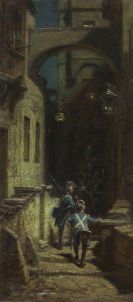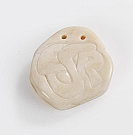
Louis Léopold Boilly
1761 La Bassée
1845 Paris
The French painter and lithographer Louis-Léopold Boilly, born on 5th July 1761 in La Bassée in Northern France, is known for his precise reproductions of everyday scenes in post-revolutionary Paris, which show the diversity of city life in all of its aspects. Bouilly’s work reflects the significant changes that accompanied the transition from Ancien Régime to the First Republic, and thus is of great historical value.
As the son of a wooden sculptor, Boilly came from a simple, but not, as is often mistakenly claimed, poor background. In the northern French province, Boilly earnt a himself a reputation early on as a painter with a broad repertoire, before moving to Paris in 1785 as an established artist, having first tested out his chances on the market. In 1791 the artist had his first exhibition in the Paris Salon. Boilly demonstrated a particular aptitude for making money. Upon moving to Paris, he adapted his artistic style to the local market conditions and made boudoir scenes- which were in demand amongst the well-heeled art patrons of the Ancien Régime - his speciality. He cultivated a style that referenced the Old Masters, which dominated private collections. Boilly’s works pre-dating the Revolution are varations on particular kinds of scenes, which are characterised by an awareness of subtle differences and symbolic content.
The decisive events of 1789 were echoed in the art produced at the time and the established group of buyers no longer existed. Boilly adapted himself to the new circumstances and focussed on portrait painting. He found his niche with standardised small –scale portraits (ca. 22 x 17 cm) which could be executed quickly, and were also affordable. This was a successful concept, and Boilly painted around 5000 of these portraits during his lifetime.
In 1794, during the Jacobite reign of terror, Jean-Baptiste Wicar, another painter, accused Boilly of corrupting public morals with his paintings, which was a common accusation at the time. In fact, in this case, Boilly was less of a victim of his circumstances as is commonly thought. He was the only person to reject the accusations, and his criticisms were acknowledged. This then increased his standing amongst the revolutionaries.
Bolly was, however, no revolutionary, as he always quick to profit financially from the current situation. He knew how to exploit new commercial opportunities. His choice of motifs ranged from private to public, from boudoir scenes with few figures, to scenes depicting the masses, from the bourgeois middle-classes to the poor. He executed everyday scenes social and political content, with which thematised the moral decline in the Directorium period, but which are, however, not easy to read. These works did not sell well, but were exhibited and served to rebuild Boilly’s reputation. He paid for his family’s upkeep with the sales of his portrait paintings.
In 1824, Boilly stopped painting and from 1829, he devoted himself exclusively to administering his finances through mortgage loans. This was not for financial reasons, as is frequently assumed, but rather stemmed from an interest in investments. In fact, it was not as unusual an interest as it appears: Rubens also stopped accepting large commissions later in his life, and instead focussed on his finances. In 1833 Boilly was named a Knight of the Legion D’Honneur. Louis-Léopold Boilly died in Paris on 4th January 1845.

Would you like to sell a work by Louis Léopold Boilly?
Infos for sellerART MARKET:

Die Scharwache
Oil on paper, laminated on panel, 1875
Estimated price 70.000
More offers >






